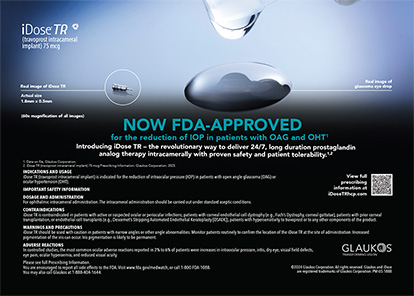
The pandemic pillaged your practice, but you survived. (Nice work!) Now let’s talk about how to thrive in this brave new world. This time is loaded with opportunity. No, COVID-19 isn’t over. A new normal is here, however, and it’s time to take advantage of it. This article describes the three most important actions you can take right now to future-proof your practice, increase your surgical volume, and take advantage of the refractive wave hitting many markets across the globe.
WHAT IS THE REFRACTIVE WAVE, AND WHY IS IT IMPORTANT?
Something unusual happened after the 2020 lockdowns began to lift early in the summer of 2020: Interest in refractive surgery started to grow. Despite the uncertainty surrounding COVID-19—or perhaps in part because of it—people began to feel an increased desire to improve their vision. Anyone who says they know why this is happening is "tellin’ tall tales," as we say in Texas. Based on my company’s data, however, and hundreds of conversations with practices and patients, the following are the most probable factors.
Foggy glasses. Anyone who wears glasses knows that wearing a mask means that the lenses will fog up and impair vision.
Eye touching. SARS-CoV-2 is spreading, and people are washing their hands like lives depend on it—which they do. Some people who wear contact lenses no longer want to deal with repositioning their contact lenses multiple times a day.
Increased convenience in lifestyle. People can work from home, shop for groceries from home, order food from restaurants from home, and work out at home. Some of those with poor vision are starting to ask, “Why am I still fixing my vision the old way?”
Fear. None of us knows what the future holds (or if the Apocalypse is coming). The fear of the unknown is driving some individuals to fix things that they can control.
How long will the so-called refractive wave last? There is no way to tell, and opportunity waits for no one. If you take one thing away from my article, let it be this: The opportunity to convert potential patients into actual patients is now, so take advantage of it.
EFFECTIVE STRATEGIES FOR GROWTH
Let’s look at the three most effective ways to get more patients in your door and grow your surgical volume.
1. LEVERAGE CONVENIENCE
The pandemic has forced consumers to change their behaviors and triggered a massive transition to home-centric consumerism. Things like virtual workouts (eg, Peloton), on-demand grocery delivery (eg, Instacart), and work-from-home accessibility (eg, Zoom) are commonplace today, causing two major mental shifts in consumer behavior.
Mental Shift No. 1: I can do a lot more from home than I thought. Easy access to technology, including smartphones, has helped people to realize they don’t have to leave home nearly as much as they used to—and they like that.
There is a challenge, however. This mental shift makes coming to your practice for an initial consultation a hurdle for many people. They have to get up, get dressed, and drive across town to see you. This may seem silly, but it’s a much bigger ask than saying, “Could you come in for your consultation on your way home from work?”
Many potential patients still prefer to come in for a consultation, just like they prefer to go to the grocery store. The point is that some members of society won’t return to the grocery store, gym, or office because they are afraid and/or realize they don’t have to. You need to be able to serve this group.
Mental Shift No. 2: I really like these new conveniences. Throughout history, convenience has driven innovation—from the original Model T car to climate control to power windows to heated seats to 360º backup cameras. Amazon is another example. It offers the conveniences of being a one-stop-shop with one-click purchasing and fast delivery.
The applicable question to your ophthalmic practice is this: How do you make your offerings more convenient to consumers? First and foremost, you need to adopt a hybrid consultation model that allows you to market, schedule, and facilitate two types of consultations: in-person and virtual. It’s not either/or. It’s both. When marketed and executed properly, this hybrid online connectivity model allows you to tap into a new subset of convenience-focused patients.
People have found new ways to gain convenience in their lives, and that’s exactly what vision correction offers them.
2. LEVEL UP YOUR TEAM’S COMMUNICATIONS AND SALES SKILLS
Another opportunity to increase patient volume in your practice lies in your team’s ability to communicate value to prospective patients. Too often, the assumption is that the team is doing OK if the practice is busy.
Doing OK turns some new patient opportunities into booked surgeries, but if you want to grow your surgical volume—and if you want to charge premium prices for your procedures (and you should because that’s the best way to serve your patients)—it takes more than doing OK.
One way to increase your ability to grow your volume is to develop your phone and counselor teams. I’ve worked with hundreds of teams over the years, and I can’t name a single practice whose staff didn’t benefit from sales and communications training, even if they were already high performers.
I guarantee you’re losing prospective patients every single day, particularly on the phones. Training your team to better identify and manage new patient opportunities will help increase the number of patients on your surgery schedule.
3. LEVERAGE THE PATIENT JOURNEY
A recent prospect attended a refractive surgery consultation. He was a great candidate for surgery, and the surgeon took the time to explain the patient’s options in detail. In the end, he was wide-eyed and speechless.
The scenario I described happens in practices across the country. It’s called choice paralysis, and it is most likely to occur at two key points in the patient journey (described below). There are strategies for educating patients and addressing their concerns during the preoperative consultation without overwhelming them.
Decision points. These are just what it sounds like: the times a patient makes a decision. Decision points include the patient’s decision to call you, book (or not book) an evaluation, show up for the consultation, and undergo surgery.
Incubation periods. These are the times between decision points. When a patient calls your practice at 1 pm on Monday and books a consultation for 11 am on Wednesday, the 46 hours between those two decision points is the incubation period.
The magic lies in the incubation periods, which should be leveraged as times to educate patients, build rapport, and create excitement about their next decision point. See Tips for Maximizing the Potential of Incubation Periods for some examples of how to build excitement in the incubation period between a patient’s initial call to your practice and the day of the actual consultation. The goal is to pre-educate the patient on your practice’s offerings and on your practice as a whole. This strategy also builds familiarity and rapport, so the patient is primed, excited, and ready to make a decision by the time they get to your consultation room.

NEXT STEPS
A massive opportunity lies before you. How long will the refractive wave last? That’s anyone’s guess. You can’t control that, but you can control your practice by positioning your team to serve more patients and change more lives.
Share this article with your administrator, your marketing team, and your salespeople and go out there and serve your patients. As crazy as this past year has been, your patients need you now more than ever.




